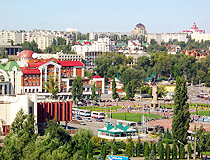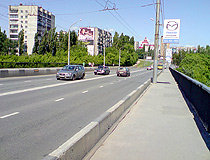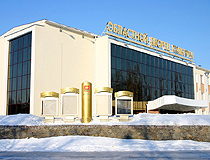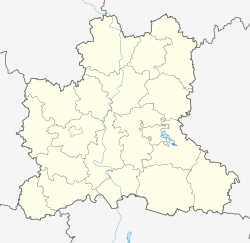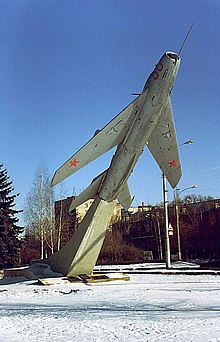Для начала узнаем точное расположение города:
Lipetsk is the city in Russia, which is situated in 445 km from the capital of Russia (Moscow). It is the administrative center of Lipetsk oblast.
Липецк это город в России, который расположен в 445 километрах от столицы России (Москва). Это административный центр Липецкой области.
Дата основания города:
Its history starts from the 1283. Lipetsk was founded near the Voronezh River. История города начинается с 1283 года. Липецк был основан на берегу реки Воронеж.
Теперь выясним площадь и население города
The area of the city is around 320 square km. The population of the city is 510 439 inhabitants. Площадь города около 320 квадратных километров. Население города-510 439 человек.
Далее укажем административное деление города
The city consists of 4 districts. They are Sovetsky, Levoberezhny, Pravoberezhny and Oktyabrsky. Город состоит из четырех административных округа. Они называются: Советский, Левобережный, Правобережный и Октябрьский
Чтобы лучше узнать город, необходимо поговорить о его достопримечательностях
The main street of the city is called Lenina. This street is considered to be a historical centre of the city. Walking along this street you can find a monument-Nativity of Christ Cathedral. It is the main cathedral of Lipetsk. –
Главная улица города носит имя Ленина. Эта улица считается историческим центром города. Прогуливаясь по этой улице можно найти памятник – Христорождественский кафедральный собор. Это главный кафедральный собор Липецка.
Another monument, which you can find in this city is monument for Peter the first. He was the founder of the city.- Еще один памятник, который Вы можете найти в этом городе это памятник Петру первому. Он был основателем города.
One more the most famous monument is Komsomol pond. The square around this pond is always used for city holidays and events. – Еще один самый известный памятник-это Комсомольский пруд. Площадь вокруг пруда всегда использовали для городских праздников и событий.
History of Lipetsk
Foundation of Lipetsk
According to one version, a fortified Slavic settlement on the site of modern Lipetsk existed even before the Mongol invasion of the mid-13th century. In the chronicles, the settlement of Lipovichsk was first mentioned in 1283-1284. In 1284, it was completely destroyed and for the next several centuries there was no mention of it.
The village of Malye Studenki Lipskie, located on the site of Lipetsk, was first mentioned in the chronicles in the first half of the 17th century. The road from Moscow to Voronezh passed through this place. Presumably from the end of the 17th century, the development of iron ores began here.
In 1703, the construction of iron plants for the needs of the Russian fleet and army began on the Lipovka River, at the place of its confluence with the Voronezh River. Soon, these plants took the second place in Russia in pig iron smelting. This year is considered the foundation date of Lipetsk.
In 1709, the village was renamed to Lipskie Zavody (“Lipskie Plants”). The traveling palace of Peter I and a number of churches were located here. The rapid expansion of production led to the need to build a unique and largest man-made water reservoir (Lipetsk pond) in pre-Soviet Russia with an area of about 0.7 square kilometers. Lipetsk became a production and logistics center for a large metallurgical complex.
In 1779, by decree of Catherine II, Lipskie Zavody received the status of a town of the Tambov Governorate with the name Lipetsk. At that time, its population was about 6 thousand people. In 1781, Lipetsk received its coat of arms, which depicted a spreading linden tree (“lipa” in Russian) on a gold background, which symbolized the name of the town.
More Historical Facts…
Lipetsk as a resort town of the Russian Empire
In 1791-1803, the Cathedral of the Nativity of Christ, the highest church in Lipetsk, was built. Today, it is still an architectural dominant of the city. The end of the Russian-Turkish war of 1787-1791 moved the Russian borders to the Northern Black Sea region and the need to maintain the Voronezh shipyards disappeared. This fact, together with the depletion of the forests used for fuel, led to the decline of industrial life in Lipetsk.
In 1795, after the opening of new iron-smelting plants in the south of the Russian Empire with a new, more advanced technology for smelting pig iron and steel, the plants in Lipetsk were closed, the bulk of the equipment and workers were transferred to the Lugansk Foundry in Lugansk.
Built for the needs of the plant, the pond in Lipetsk stood out not only in size, but also in its absence of fish. This fact was noticed by the local population. In 1800, Vander, a county medical doctor, reported to the medical board about the healing properties of local mineral waters.
In 1805, a chemical analysis showed the similarity of the Lipetsk mineral waters with the waters of the famous Western European resorts. As it was the time of the Napoleonic wars and social tension in Europe, the resort in Lipetsk gained popularity in the high society of the Russian Empire as a Russian analogue of the Belgian Spa. In 1806, on the territory of the plant and pond, an “English garden” was laid out. Later, it was named Nizhniy Park and became the largest city park in Lipetsk.
In 1806, a big fire broke out in the wooden chaotically built up Lipetsk. After it, the town was rebuilt according to the General Plan with straight wide streets and buildings made of stone and brick. Resort buildings, a hotel, an entertainment hall were built. Noble and merchant mansions were constructed on Dvoryanskaya (Lenina) Street.
In 1862, there were 11,659 residents in Lipetsk. The city had 8 Orthodox churches, 3 schools, a hospital and a post station, three fairs, and five factories producing mainly candles and soap. In 1868-1869, the South-Eastern Railway passed through the city. By the last third of the 19th century, the resort also offered mud, peat, and kumis therapies.
Lipetsk in the first half of the 20th century
In the late 19th and early 20th centuries, the industry of Lipetsk was revived, when, in connection with the expansion of railway construction, Russian and foreign entrepreneurs decided to re-use the iron ore deposits near Lipetsk. According to the all-Russian census, a little more than 20 thousand people lived in the city at that time. In 1899, the construction of the first blast furnace of the Sokolsky Metallurgical Plant began. During the First World War, aircraft construction began to develop in Lipetsk.
In 1921, the Lipetsk Drama Theater was opened. Lipetsk continued to develop as an aviation center. In 1923, an aviation school was opened in Lipetsk to train a new generation of Soviet aviators. But the existing knowledge, technology, and financial resources were lacking. That’s why, in 1925, it was decided to organize a secret joint Soviet-German aviation school here. After Hitler came to power in Germany, it was closed. In 1934, the Red Army Air Force Higher Tactical Flight School was opened in its place.
In 1931, the Novolipetsk Metallurgical Plant was founded. Today, it is known as Novolipetsk Steel or NLMK, one of the largest steel companies in Russia. The construction of this enterprise became a turning point in the history of Lipetsk. Lipetsk turned into a large industrial center. In 1939, the population of Lipetsk was 66,644 people.
During the Second World War, evacuation hospitals were organized on the territory of Lipetsk. In total, up to 40 hospitals functioned in the city during the war. In the period from 1941 to 1942, and then until the end of the war, equipment, several shops and a blast furnace of the metallurgical plant were evacuated to Chelyabinsk and were not returned back. About 7 thousand residents of the city mobilized into the ranks of the Red Army were killed in battles.
In the first years after the war, the local industry was intensively restored. In 1947, the first tram line was opened. In 1949, the pedagogical school of Lipetsk was transformed into the first higher educational institution of the city — Lipetsk Pedagogical Institute.
Lipetsk — the capital of Lipetsk Oblast
On January 6, 1954, during the downsizing of a number of regions of central Russia, a separate Lipetsk Oblast was created, and the city of Lipetsk received the status of a regional center. In 1956, the population of Lipetsk was about 123,000.
The regional capital status allowed the city to develop intensively. Construction of many regional institutions began, roads were paved, a large-scale program of landscaping and street lighting was carried out. In 1966, a direct railway connection with Moscow was opened, and the building of the Lipetsk airport was constructed. In 1989, the population of Lipetsk was 449,635 people.
In the early 1990s, because of the collapse of the USSR, a lot of local industrial enterprises found themselves in a difficult situation, failed to adapt to the market economy, and went bankrupt. However, the city continued to develop.
In 1993, the plant for the production of refrigerators “Stinol” was opened on the basis of the Novolipetsk Metallurgical Plant. It was built by the Italian company Merloni (since 2005 — Indesit). In 1996, the second monument to Peter the Great was opened in Lipetsk, which became an important landmark of the city center.
In 2002-2005, there was a significant reduction in tram transport. In 2004, the washing machine plant “Indesit” was built. In 2008, the special economic zone “Lipetsk” was opened — an industrial area with benefits for foreign capital.
Today, Lipetsk is known as a major producer of steel and rolled products, building materials, household appliances, juices, and mineral water, as well as a training center for Russian pilots. The aerobatic team “Falcons of Russia” is based in Lipetsk.
Pictures of Lipetsk
Peter the Great Square and general view of Lipetsk
On the street in Lipetsk
Author: Dmitry Lelikov
Regional Palace of Culture in Lipetsk
Author: Sergey Polovinkin
Lipetsk — Features
Lipetsk is located on both banks of the Voronezh River in the forest-steppe zone in the east of Lipetsk Oblast in the central part of European Russia. The length of the city from north to south is 22 km, from west to east — 27 km. The City Day of Lipetsk is celebrated on the 3rd Sunday of July.
The climate is temperate continental. Despite the fact that Lipetsk is located at the latitude of Berlin and Amsterdam, winter in the city is with a stable snow cover, the average temperature in January is minus 7.3 degrees Celsius. Summer is warm, the average temperature in July is about plus 20 degrees Celsius.
Lipetsk is the core of the largest agglomeration in Russia with a specialization in the field of full cycle ferrous metallurgy, as well as an industrial, agro-technological, and aviation center. The main enterprise of the city is Novolipetsk Steel (NLMK), which is the largest steel plant in Russia.
The main supplier of raw materials for the enterprise is the Kursk Magnetic Anomaly, one of the largest deposits of iron ore in the world located about 350 km from Lipetsk. NLMK is also the city’s largest air pollutant, although pollution levels have been gradually decreasing in recent years.
The city is located between the federal highways “Don” and “Caspian” and has a developed network of industrial railways. The airport of Lipetsk is located 15 km north-west of the city center and offers regular flights to Moscow. Buses and trams are used as urban public transport.
Better known as a city of metallurgists than as an interesting tourist destination, Lipetsk deserves at least a few hours of attention. Walking around the city center, seeing its historical sights, walking through old parks and alleys, visiting places that are significant for Lipetsk — one day of unhurried sightseeing is quite enough for this.
Main Attractions of Lipetsk
Peter the Great Square — the main festive events in Lipetsk are held on this square including the City Day. One of the symbols of Lipetsk is installed here — the monument to Peter the Great (1996). In 2006, a light and music fountain was opened on the square.
Cathedral of the Nativity of Christ (1791-1842) — a majestic Orthodox church located at Sobornaya (Lenina) Square, the second main square of Lipetsk. It is the spiritual center of Lipetsk and the architectural dominant of the city visible from afar. The height of the bell tower with a spire and a clock is 60 meters. In this square, you can also find a grand staircase with a cascade of fountains next to which there is the stele to Emperor Peter the Great (1869).
Nizhniy (Lower) Park — the largest park in Lipetsk founded in 1805. The green area of the park mainly consists of linden and oak trees. On the territory of this park you can find the house-museum of Peter the Great, a pavilion with mineral water, rides for children and adults including a Ferris wheel, several monuments, a zoo, a planetarium, several cafes.
Komsomolsky Pond — an artificial reservoir in Lipetsk located on the opposite side of Petrovskiy Proyezd from Nizhniy Park. In 2003, a monument was erected here in honor of the 300th anniversary of the city of Lipetsk — a gilded ship with very high masts placed on a column.
Lipetsk Regional Museum of Local Lore — the central museum of Lipetsk Oblast. In total, there are 18 exhibition halls, where you can see exhibits on the history of the Lipetsk region from antiquity to the present day: paintings, icons, old books, ethnographic materials, a collection of toys of the 19th-20th centuries, furniture, jewelry, outfits of nobles, weapons of the Second World War, and even a wax figure of Peter I. Lenina Street, 25.
Lipetsk Regional Art Museum. The museum is opened in a former merchant house — an architectural monument of the 19th century. The collection has about 2 thousand works of Russian artists from 1930 to the present: paintings, sculptures, graphics, examples of decorative and applied art. Lenina Street, 7?.
Art Museum named after V.S. Sorokin (House of the Master) — a two-story mansion built in the Art Nouveau style in 1910, an architectural monument. Artworks created by Russian authors of the 20th century are exhibited here including a large collection of paintings of the artist Viktor Sorokin. Lenina Street, 2.
Fine Arts Center. In the halls of this center, opened in 2007, the works of contemporary artists of Lipetsk and Russia are exhibited: paintings, souvenirs, arts and crafts, graphics. Kosmonavtov Street, 98.
Lipetsk Museum of Folk and Decorative and Applied Arts — one of the youngest museums in the Lipetsk region with unique exhibits. In total, the museum has about 7,000 exhibits. Here you can see items of peasant life, traditional folk costumes, examples of folk crafts and handicrafts of the Lipetsk land. Kosmonavtov Street, 2.
Lipetsk Park of Miniatures in “Bykhanov Sad” Park. Here you can see models of the most interesting buildings of Lipetsk and neighboring towns such as Yelets, Lebedyan, Dankov, as well as villages of the Lipetsk region. Gagarina Street, 70b.
Church of the Venerable Martyr Evdokia (1817-1818) — a picturesque Orthodox church in the classical style, a historical and cultural monument located in the center of Lipetsk. Gagarina Street, 70.
Aviatorov (Aviators) Square. The main attraction of this square is a combat aircraft installed on a pedestal in 1969 in honor of the pilots of the Lipetsk air squadron. In 2003, the figures of the pilots L.A. Krivenkov and S.M. Sherstobitov were placed next to the monument. In 1968, their aircraft broke down in the sky over Lipetsk and, at the cost of their lives, they took it away from residential areas.
Not to be confused with Lipetske.
|
Lipetsk Липецк |
|
|---|---|
|
City[1] |
|

In Lipetsk |
|
|
Flag Coat of arms |
|
| Anthem: none[2] | |
|
Location of Lipetsk |
|
|
Lipetsk Location of Lipetsk Lipetsk Lipetsk (Lipetsk Oblast) |
|
| Coordinates: 52°37′N 39°36′E / 52.617°N 39.600°ECoordinates: 52°37′N 39°36′E / 52.617°N 39.600°E | |
| Country | Russia |
| Federal subject | Lipetsk Oblast[1] |
| Founded | 1703[3] |
| City status since | September 27, 1779[3] |
| Government | |
| • Body | Council of Deputies[4] |
| • Head[4] | Yevgenia Uvarkina[5] |
| Elevation | 160 m (520 ft) |
| Population
(2010 Census)[6] |
|
| • Total | 508,887 |
| • Estimate
(2018)[7] |
509,735 (+0.2%) |
| • Rank | 36th in 2010 |
|
Administrative status |
|
| • Subordinated to | Lipetsk City Under Oblast Jurisdiction[1] |
| • Capital of | Lipetsk Oblast[1], Lipetsky District[1] |
|
Municipal status |
|
| • Urban okrug | Lipetsk Urban Okrug[8] |
| • Capital of | Lipetsk Urban Okrug[8], Lipetsky Municipal District[8] |
| Time zone | UTC+3 (MSK |
| Postal code(s)[10] |
398000–398002, 398004–398007, 398011, 398013–398017, 398019, 398020, 398024–398027, 328029, 328032, 328035–328038, 328040–328043, 328046, 328048, 328050, 328054–328056, 328058, 328059, 328070, 328700, 328899, 328910, 328999 |
| Dialing code(s) | +7 4742 |
| OKTMO ID | 42701000001 |
| City Day | Third Sunday in July[11] |
| Website | www.lipetskcity.ru |
| 2010 Census | 508,887[6] |
|---|---|
| 2002 Census | 506,114[12] |
| 1989 Census | 449,635[13] |
| 1979 Census | 395,638[14] |
Lipetsk (Russian: Липецк, IPA: [ˈlʲipʲɪtsk]), also romanized as Lipeck, is a city and the administrative center of Lipetsk Oblast, Russia, located on the banks of the Voronezh River in the Don basin, 438 kilometers (272 mi) southeast of Moscow. Population: 496,403 (2021 Census);[15] 508,887 (2010 Census);[6] 506,114 (2002 Census);[16] 449,635 (1989 Census).[17]
History[edit]
Lipetsk was first mentioned in the 13th century chronicles.[citation needed] The name means «Linden city» and is cognate with Leipzig and Liepāja.[18] In 1284, the city was destroyed by the Mongols.
The foundation of the modern city dates back to 1703,[3] when Peter the Great ordered construction of a cast iron factory in Lipetsk near the iron ore deposits for making artillery shells.[citation needed] On September 27, 1779, Lipetsk was granted town status.[3] It became one of the principal towns of Tambov Governorate.
In 1879, Lipetsk hosted a congress of members of Land and Liberty.
After the Treaty of Rapallo (1922) until 1933, the much-reduced German Army (Reichswehr) of the Weimar Republic secretly contracted with Soviet authorities to operate a clandestine military aviation base and test facility near Lipetsk – circumventing prohibitions of the Versailles Treaty. The base enabled technical collaboration by the two powers whose separate defeats in World War I left them isolated in post-war Europe. This activity inside the U.S.S.R. took place away from the vigilant eyes of the victors.[19]
The Abwehr, The SS and German Army Group Centre penetrated part of this Lindenstadt Region in 1941-2.
Administrative and municipal status[edit]
Lipetsk is the administrative center of the oblast and, within the framework of administrative divisions, it also serves as the administrative center of Lipetsky District, even though it is not a part of it.[1] As an administrative division, it is incorporated separately as Lipetsk City Under Oblast Jurisdiction—an administrative unit with a status equal to that of the districts.[1] As a municipal division, Lipetsk City Under Oblast Jurisdiction is incorporated as Lipetsk Urban Okrug.[8]
Economy[edit]
The principal industries of Lipetsk include ferrous metallurgy, machinery, metalworking, machine tools, engines, chemicals, food, and clothing.
The former steel combine was privatized in 1992 and Novolipetsk Steel (NLMK) with approximately 48,000 employees and a 64% export ratio (2005) is one of the largest employers in the oblast. In 2008, the company’s revenue was $11.7 billion.[20] Other industry are another metallurgical plant «Svobodny Sokol» («Free Falcon»), a tractor factory LTZ, solvent-extraction plant Liboil (largest rapeseed oil producer in Central Federal District and the second in Russia), pipe factory, a factory for refrigerators and household appliances, an ice factory, lathe factory, chemical factories, etc. Industry is mainly located south of the Voronezh River.
Transportation[edit]
Since 1868, there is a railway connection between Lipetsk and Moscow.[21] Trams, trolleybuses and buses provide local public transportation. The municipality aspires to renovate the tramway network as it is largely segregated from motor traffic. It has negotiated a 10-year, RUR 30 billion loan from the European Bank of Reconstruction & Development for tramway renewal.[22]
Health care[edit]
Lipetsk is one of the oldest mud bath and balneological resorts in Russia (first opened in 1805). Peat mud and chalybeate bicarbonate calcic springs are used to treat patients. Sulphate and chloride sodium water is used for therapeutic baths and drinking.
Education[edit]
Lipetsk State Academic Drama Theater named after Leo Tolstoy
Lipetsk is home of the Lipetsk State Technical University, Lipetsk State Pedagogical University, and some other colleges.
Military[edit]
MiG-19 on the plinth in front of 4th Center of Combat Application and Conversion of Frontline Aviation
At the Lipetsk Air Base north of the town, the 4th Center of Combat Application and Conversion of Frontline Aviation named after Valery Chkalov is situated in Lipetsk.
The Lipetsk Air Center’s chief, colonel Kharchevsky, has become famous after trial air combats in the United States and being a personal pilot of President Putin.
The city is also served by the smaller Lipetsk Airport.
Twin towns and sister cities[edit]
Lipetsk is twinned with:
| Country | City | Start |
|---|---|---|
| Cottbus[23] | 1974 | |
| Anshan | 1992 | |
| Fabriano | 2003 | |
| Vinnytsia |
Notable people from Lipetsk[edit]
- Andrei Gheorghe
- Viktor Kukin
- Alexandre Naoumenko
- Dmitri Shershnev
- Eugene Smurgis
- Maria Viktorovna
- Dmitry Kulikov
See also[edit]
- List of Chairmen of the Council of Deputies of Lipetsk Oblast
References[edit]
Notes[edit]
- ^ a b c d e f g Law #382-OZ
- ^ Article 3 of the Charter of Lipetsk states that the city may have its own anthem; however, as of 2015 no anthem has been adopted.
- ^ a b c d Charter of Lipetsk, Article 1
- ^ a b Charter of Lipetsk, Article 5
- ^ Official website of Lipetsk. Sergey Vyacheslavovich Ivanov, Head of Lipetsk (in Russian)
- ^ a b c Russian Federal State Statistics Service (2011). Всероссийская перепись населения 2010 года. Том 1 [2010 All-Russian Population Census, vol. 1]. Всероссийская перепись населения 2010 года [2010 All-Russia Population Census] (in Russian). Federal State Statistics Service.
- ^ «26. Численность постоянного населения Российской Федерации по муниципальным образованиям на 1 января 2018 года». Federal State Statistics Service. Retrieved January 23, 2019.
- ^ a b c d Law #536-OZ
- ^ «Об исчислении времени». Официальный интернет-портал правовой информации (in Russian). June 3, 2011. Retrieved January 19, 2019.
- ^ Почта России. Информационно-вычислительный центр ОАСУ РПО. (Russian Post). Поиск объектов почтовой связи (Postal Objects Search) (in Russian)
- ^ Charter of Lipetsk, Article 4
- ^ Russian Federal State Statistics Service (May 21, 2004). Численность населения России, субъектов Российской Федерации в составе федеральных округов, районов, городских поселений, сельских населённых пунктов – районных центров и сельских населённых пунктов с населением 3 тысячи и более человек [Population of Russia, Its Federal Districts, Federal Subjects, Districts, Urban Localities, Rural Localities—Administrative Centers, and Rural Localities with Population of Over 3,000] (XLS). Всероссийская перепись населения 2002 года [All-Russia Population Census of 2002] (in Russian).
- ^ Всесоюзная перепись населения 1989 г. Численность наличного населения союзных и автономных республик, автономных областей и округов, краёв, областей, районов, городских поселений и сёл-райцентров [All Union Population Census of 1989: Present Population of Union and Autonomous Republics, Autonomous Oblasts and Okrugs, Krais, Oblasts, Districts, Urban Settlements, and Villages Serving as District Administrative Centers]. Всесоюзная перепись населения 1989 года [All-Union Population Census of 1989] (in Russian). Институт демографии Национального исследовательского университета: Высшая школа экономики [Institute of Demography at the National Research University: Higher School of Economics]. 1989 – via Demoscope Weekly.
- ^ Всесоюзная перепись населения 1979 г. Национальный состав населения по регионам России [All Union Population Census of 1979. Ethnic composition of the population by regions of Russia] (XLS). Всесоюзная перепись населения 1979 года [All-Union Population Census of 1979] (in Russian). 1979 – via Demoscope Weekly (website of the Institute of Demographics of the State University—Higher School of Economics.
- ^ Russian Federal State Statistics Service. Всероссийская перепись населения 2020 года. Том 1 [2020 All-Russian Population Census, vol. 1] (XLS) (in Russian). Federal State Statistics Service.
- ^ Russian Federal State Statistics Service (May 21, 2004). Численность населения России, субъектов Российской Федерации в составе федеральных округов, районов, городских поселений, сельских населённых пунктов – районных центров и сельских населённых пунктов с населением 3 тысячи и более человек [Population of Russia, Its Federal Districts, Federal Subjects, Districts, Urban Localities, Rural Localities—Administrative Centers, and Rural Localities with Population of Over 3,000] (XLS). Всероссийская перепись населения 2002 года [All-Russia Population Census of 2002] (in Russian).
- ^ Всесоюзная перепись населения 1989 г. Численность наличного населения союзных и автономных республик, автономных областей и округов, краёв, областей, районов, городских поселений и сёл-райцентров [All Union Population Census of 1989: Present Population of Union and Autonomous Republics, Autonomous Oblasts and Okrugs, Krais, Oblasts, Districts, Urban Settlements, and Villages Serving as District Administrative Centers]. Всесоюзная перепись населения 1989 года [All-Union Population Census of 1989] (in Russian). Институт демографии Национального исследовательского университета: Высшая школа экономики [Institute of Demography at the National Research University: Higher School of Economics]. 1989 – via Demoscope Weekly.
- ^ «Происхождение названий. БЛАГОДАРЯ КАЗУСАМ И ВПЕЧАТЛЕНИЯМ».
- ^ Wolf Oschlies: Symbiose der Geächteten. Preußische Allgemeine Zeitung, Nr. 38, 19. September 2009, p. 10
- ^ Novolipetsk Steel posts $480 net loss for Oct.-Dec. 2008
- ^ «Train Station in Lipetsk» (in Russian). Archived from the original on September 29, 2013. Retrieved December 2, 2012.
- ^ «Two Russian cities get EBRD infrastructure loans [EBRD — News and events ]». Archived from the original on January 21, 2013. Retrieved January 2, 2013.
- ^ «Our twin cities- Cottbus». Cottbus. Archived from the original on November 4, 2013. Retrieved June 24, 2013.
Sources[edit]
- Липецкий городской Совет депутатов. Решение №990 от 24 февраля 2015 г. «Устав городского округа город Липецк Липецкой области Российской Федерации», в ред. Решения №116 от 26 апреля 2016 г «О внесении изменений в Устав городского округа город Липецк Липецкой области Российской Федерации». Вступил в силу 21 марта 2015 г. (за исключением отдельных положений). Опубликован: «Липецкая газета», №55, 21 марта 2015 г. (Lipetsk City Council of Deputies. Decision #990 of February 24, 2015 Charter of the Urban Okrug of the City of Lipetsk of Lipetsk Oblast of the Russian Federation, as amended by the Decision #116 of April 26, 2016 On Amending the Charter of the Urban Okrug of the City of Lipetsk of Lipetsk Oblast of the Russian Federation. Effective as of March 21, 2015 (with the exception of certain clauses).).
- Липецкий областной Совет депутатов. Закон №382-ОЗ от 28 апреля 2010 г. «Об административно-территориальном устройстве Липецкой области и порядке его изменения», в ред. Закона №343-ОЗ от 5 декабря 2014 г. «О внесении изменений в некоторые Законы Липецкой области в связи с объединением сельских поселений Добринский сельсовет и Сафоновский сельсовет Добринского муниципального района Липецкой области». Вступил в силу по истечении 10 дней со дня официального опубликования. Опубликован: «Липецкая газета», №88, 7 мая 2010 г. (Lipetsk Oblast Council of Deputies. Law #382-OZ of April 28, 2010 On the Administrative-Territorial Structure of Lipetsk Oblast and on the Procedures for Its Change, as amended by the Law #343-OZ of December 5, 2014 On Amending Various Laws of Lipetsk Oblast Due to the Merger of the Rural Settlements of Dobrinsky Selsoviet and Safonovsky Selsoviet in Dobrinsky Municipal District of Lipetsk Oblast. Effective as of the day which is 10 days after the day of the official publication.).
- Липецкий областной Совет депутатов. Закон №114-ОЗ от 2 июля 2004 г. «О наделении муниципальных образований в Липецкой области статусом городского округа, муниципального района, городского и сельского поселения», в ред. Закона №343-ОЗ от 5 декабря 2014 г. «О внесении изменений в некоторые Законы Липецкой области в связи с объединением сельских поселений Добринский сельсовет и Сафоновский сельсовет Добринского муниципального района Липецкой области». Вступил в силу со дня официального опубликования. Опубликован: «Липецкая газета», №131, 8 июля 2004 г. (Lipetsk Oblast Council of Deputies. Law #536-OZ of August 18, 2011 On Granting Urban Okrug, Municipal District, Urban and Rural Settlement Status to the Municipal Formations of Lipetsk Oblast, as amended by the Law #343-OZ of December 5, 2014 On Amending Various Laws of Lipetsk Oblast Due to the Merger of the Rural Settlements of Dobrinsky Selsoviet and Safonovsky Selsoviet in Dobrinsky Municipal District of Lipetsk Oblast. Effective as of the day of the official publication.).
External links[edit]
- Official website of Lipetsk (in Russian)
- Unofficial website of Lipetsk (in Russian)
- Lipetsk news (in Russian)
- Website of Lipetsk Chamber of Commerce and Industry

